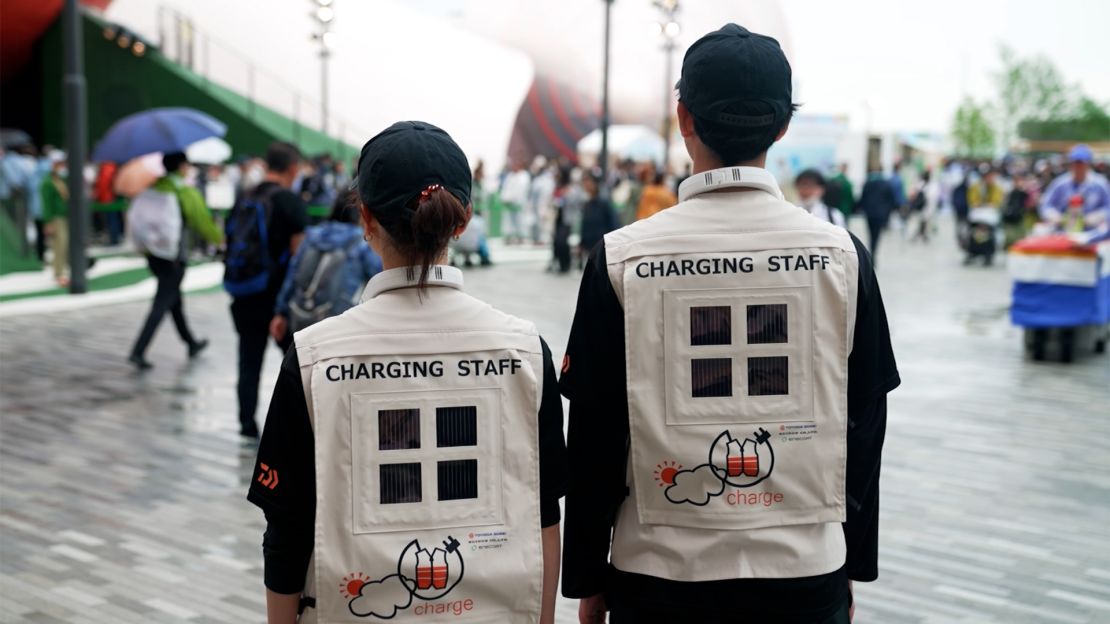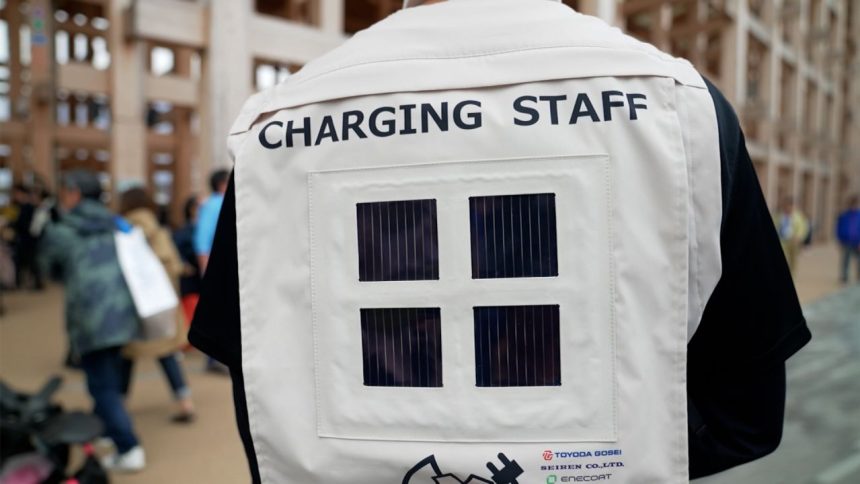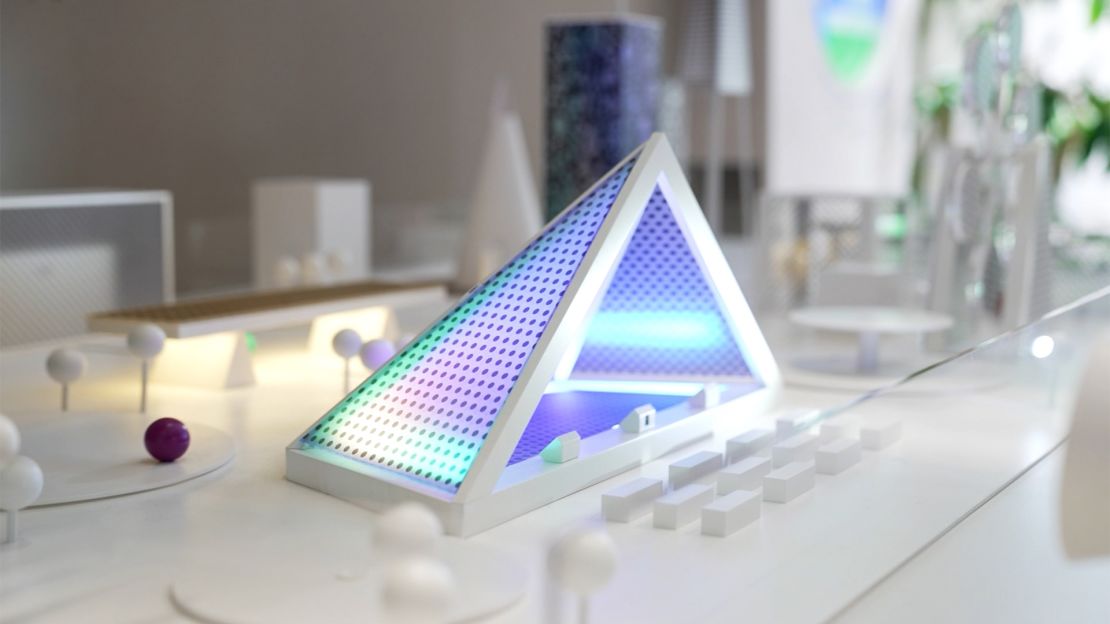CNN
—
As summer temperatures in Osaka, Japan, soar closer to 100 degrees Fahrenheit, staff at Expo 2025 are beating the heat with utility vests that are powered by the sun.
Developed by Toyota Group company Toyoda Gosei, in collaboration with solar cell startup Enecoat Technologies and textile manufacturer Seiren, the utility vests are fitted with ultra-thin, flexible solar panels that weigh less than four grams each — lighter than a single sheet of paper — and power neck fans to keep the wearer cool.
These solar “films” aren’t like the silicon panels installed on roofs or solar farms, which account for 98% of the solar energy market today. Instead, they’re made of perovskites, a family of crystals that share the same characteristic structure.
Perovskite solar cells are lighter, cheaper to produce, and can be tuned to absorb a broader range of light, including visible and near-infrared. They can even be charged “under shade, in rainy and cloudy weather,” says Shinichiro Fuki, director of the Toyoda Gosei team behind the vest.

In the lab, Enecoat’s solar film has achieved 21.2% efficiency, meaning around a fifth of the solar energy is converted to electricity. Now, it is being tested in real-world conditions at the Expo.
The team is gathering data daily on how it responds to different climate conditions, such as solar radiation and temperature, as well as the performance of the mobile battery that it connects to, which is expected to fully charge in five to 10 hours.
According to Fuki, the project is a “world-first initiative” to integrate perovskite solar cells into wearables. “We hope people who work in an environment where they cannot easily obtain power without solar power will use and wear it,” he adds.
Low-light solar

Perovskites can be found in nature or made in a lab, and their use in solar cells was first demonstrated in 2009 by researchers in Japan.
In lab settings, perovskites have achieved power conversion efficiencies of more than 26% — around the same as the best-performing silicon solar panels today, which have nearly hit their efficiency limit.
One of the greatest advantages of perovskites is their ability to “generate power indoors or in low-light environments,” says Tamotsu Horiuchi, director and chief technology officer at Enecoat Technologies.
“When indoors, instead of sunlight, the light of LEDs, fluorescent lights, or similar lights, will be used to produce power,” says Horiuchi. And because they are more flexible and lightweight than silicon panels, “we can install solar panels even in places where it was impossible before,” he adds — such as roofs that can’t support silicon solar panels, which can weigh up to around 50 pounds (23 kilograms).
The vests aren’t the only demonstration of perovskites at the Expo: Polish company Saule Technologies has deployed curved solar cells in “smart poles” that power street lights, security cameras, digital signage and wireless charging, and Japanese company Sekisui Chemical is demonstrating its one-millimeter-thick solar film on the roof of the event’s bus terminus.
At the Panasonic Group pavilion, perovskite solar cells sandwiched between layers of glass to provide added durability have been transformed into an artistic facade to showcase the aesthetic potential of the technology.
“The current (silicone) solar panels are difficult to install in our living space,” says Yoshiteru Hara, technical director of the Panasonic pavilion at Expo 2025 Osaka. “We need to make a balance between design and power generation efficiency.”
High-powered, short-lived
Japan is investing heavily in perovskite technology to meet ambitious goals of generating 20 gigawatts of solar energy by 2040, the equivalent power produced by about typical 20 nuclear power plants. The nation is the world’s second-largest producer of iodine, a key ingredient in perovskites, and the country’s mountainous terrain limits the potential development of traditional solar farms, which require huge amounts of flat land.
However, despite the advantages, perovskites degrade faster than silicon when exposed to heat, moisture or UV rays, losing efficiency in a few years, months or even weeks.
“Everybody right now is working on stability: that’s the only thing that perovskites lack and still don’t have in comparison to silicon,” says Dr Hashini Perera, a postgraduate research fellow at the University of Surrey’s Advanced Technology Institute, where she studies perovskites.
Researchers are exploring different ways to make perovskites more durable, such as adding “stabilizing agents” or encasing the film in protective layers, such as glass, says Perera, whose recent research discovered a method that could increase the material’s lifespan tenfold.
Another challenge of perovskites is that they contain lead, which is toxic. Studies have shown that if damaged this could present an environmental risk, but Perera says that the potential for lead leakage is very low, particularly with robust encapsulation methods.
While solar cells using just perovskite might still have a long road to commercialization, it’s already improving existing panels: last year, Oxford PV, a company spun out of the University of Oxford physics department, launched the first commercial perovskite-on-silicon tandem panels in the US, delivering up to 20% more energy than standalone silicon cells.
“It’s a massive step forward for perovskites,” says Perera.
Perovskite’s ability to bring energy generation into urban areas, closer to where it’s used, will also make future cities more efficient, says Horiuchi, chief technology officer at Enecoat.
“It’s more effective to use the electricity generated right there (on-site) to power the building itself,” says Horiuchi, adding: “The same is true for clothing. I think the best way to use it is… on a smartwatch or your smartphone. I think it would be good to develop it in that way.”
Additional reporting by Yumi Asada, CNN.





